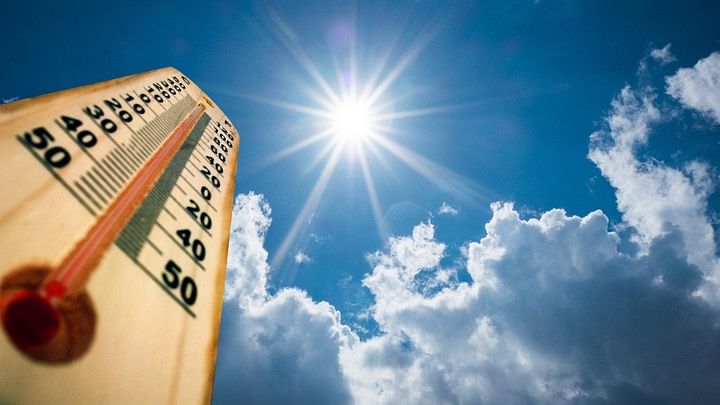
Climate change is making heat waves more frequent, more intense and longer-lasting. (Representative image)
Credit: iStock Photo
By Mark Gongloff
The early days of Covid-19 were a nightmare of packed hospitals and the constant wail of ambulances, the kind of apocalyptic scenes nobody wants to experience again. Now imagine them happening every summer but without a pandemic.
A week after Hurricane Beryl made landfall near Houston as a Category 1 storm, more than 200,000 households in the area were still without power. That meant hundreds of thousands of Texans had gone several days without air conditioning during a heat wave that relentlessly pushed heat indexes above 100 degrees Fahrenheit. The result was a health-care emergency with uncomfortable reminders of Covid’s worst hours.
“I worked through Covid, and I’ll be honest: The last few days have been some of the worst and kind of up there with as bad as Covid was,” Houston emergency physician Owais Durrani told CNN on Sunday. “Every room in the ER is filled, every hallway has stretchers from end to end.”
Some of these emergencies arose from the simple lack of electricity, such as patients suffering from kidney failure because dialysis clinics lacked power or people running generators indoors and succumbing to carbon-monoxide poisoning. But many were the result of extreme heat. Along with dehydration and heatstroke, high temperatures worsen heart and breathing ailments, diabetes, mental illness and more. (Adding insult to injury, Texas is also experiencing an actual Covid outbreak, according to wastewater data.)
Beryl is the latest in what climate scientists call “compound events,” or disaster combo meals, to hit Texas in recent years. But the marriage of extreme heat and a lack of power is a particularly toxic compound. Last month, I wrote about the concept of a “heat Katrina” — the combination of a power failure during a heat wave resulting in many deaths — and suggested a slow-motion event of that sort has been happening in Phoenix for the past few years. Houston’s example is even more apt. Though it hasn’t yet taken many lives, any deaths under these circumstances are preventable tragedies.
Cities everywhere must do a better job of protecting people during extreme-heat events, which are growing more common as the planet warms. Climate change is making heat waves more frequent, more intense and longer-lasting. And heat-wave season — the time between the year’s first heat wave and the last — has grown, by up to two months in some parts of Texas, according to Environmental Protection Agency data.
Texas suffered 334 heat-related deaths in 2023, the third record-breaking year in a row, during what was also the state’s hottest year ever. Of course, Texas and Phoenix are some of the hottest places in the country. But this isn’t just a Texas or Phoenix problem. People are as likely to get sick during a heat wave in a place unaccustomed to high temperatures as in a place where bodies are better acclimated and where AC is more ubiquitous. More than 2,300 people died from heat in the US last year, another record.
And those numbers wildly underestimate heat’s true impact on health and mortality, as Bloomberg Green has written. Though it can kill people in obvious ways, it more often takes lives without leaving fingerprints. It took scientists years to realize a mysterious spate of severe kidney disease among young Sri Lankan men was due in part to the effects of high heat, the New York Times reported recently.
The heat wave gripping Houston and the rest of the Western US, smashing records and taking lives from Oregon to Death Valley, has moved east. As of this writing, New York City is already experiencing its third heat wave of the year, and it’s only mid-July. In fact, few places on Earth have been safe from the heat this summer after 13 months that have been the hottest in human history. More than 1,300 pilgrims died during the Hajj in Saudi Arabia; Mexico City came close to running out of water; and Japan had to add a new category to its heatstroke index.
This is heat at a level we’ve never seen before — and the truly scary thing is that this will probably be one of the coolest summers we’ll ever enjoy again. Humanity’s greenhouse-gas emissions have warmed the planet about 1.3 degrees Celsius above preindustrial averages so far (though Earth has been about 1.5C warmer over the past year, in part because of the El Niño weather pattern). With at least 2.5C of warming in store under current policies, these heat waves will become even more frequent and extreme.
That doesn’t mean they have to be so deadly. Keeping the power running sure would help, Texas. In cities where the urban heat-island effect makes temperatures even higher, we need to plant a lot more trees, especially in low-income neighborhoods. We need more cooling centers along with armies of people to make sure the most vulnerable people get to them. The Federal Emergency Management Agency needs to finally recognize heat waves as natural disasters, making federal money available to help local governments keep people alive.
Heat is deadlier than hurricanes, tornadoes, floods and other climate-related disasters. But it moves slowly, and we have ways to fight it. Like Covid, it will stick around forever. We have to learn to coexist with it.